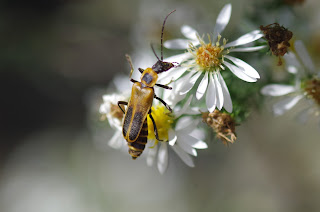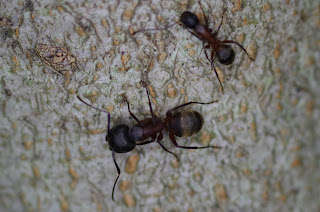A lot of the trees in the backyard started early. Some of them didn't even change color first. I think it has more to do with the drought (we are officially in a severe drought now) than the season. A lot of people in this part of the country say that autumn is their favorite season, mostly because they love the colors, and the "crisp" fall air, but I don't much care for it. It's the season of things dying, or at least looking like they are. Colored leaves are a sign that the tree isn't getting enough daylight, or something like that. They turn yellow, red, and orange because of a lack of chlorophyll to make them look green. And I LIKE green. Now I just start waiting for springtime. Spring is pretty colorful too, in case nobody noticed.
But thinking about this season of transition into dormancy (sounds better than death, right? And it's not like the trees are actually dying), while it is as hot as a summer day, I got to thinking about the progressions of things in nature. And then I saw a lot of different insect behavior today that was about life phases. So, today in the backyard we get to see life cycles in action.
But first, Backyard Bug of the Day:
Now, the Circle of Life:
You know how it starts...
Then there's the laying of eggs:
The only time I don't like to see butterflies: when it's a cabbage white laying eggs on the Brussels sprouts in the garden.
The female white marked tussock moth laid more eggs today.
I don't have any pictures of hatching/hatchlings. But speaking of that:
Just two ants left in the spot where the ants were congregated around the aphid and her young yesterday. And I scared one of them away, so then there was one.
If you're a bug, you start out small (very small nymph of a milkweed bug, but I don't know if it's a small milkweed bug or a large milkweed bug).
You go through stages of growth.
This looks like an assassin bug nymph, but it's a new one for me. I have seen something similar in other colors, but I have never seen a white one.
Finally, I found a looper caterpillar on a milkweed plant!
Then you become an adult! Or, if you are an insect, not a person, an imago!
You eat:
American copper butterfly, I think.
And then after you eat...
Winter firefly. Some days you get to see beautiful things. Other days you get to see insects urinate.
Speaking of which, there was an insect called a sharpshooter on this vine. Sharpshooters are a kind of planthopper. They don't really like having their picture taken, which is why there isn't one in this picture. But the reason sharpshooters are called sharpshooters has to do with the way they expel honeydew. I saw this one shoot out a few drops, and then it hopped away before I could get its picture. But here's the honeydew. I have no idea why I am posting this picture. Or why I took it. But... here it is.
Life has its hardships:
Winter firefly with parasite
And then...
It's a bug-eat-bug world. Life for this assassin bug means death for this bee.
And there's retribution for the cabbage white for contributing to the destruction of my Brussels sprouts:
Just kidding. I have no idea if this is the same butterfly; it's in a totally different part of the yard, and there are a LOT of cabbage white butterflies around. But you know what it means when you see a butterfly dangling oddly from a flower...
There's an ambush bug, and the butterfly has fallen prey to it.
And that's life as a bug.
For more predatory arthropod behavior, check out today's spiders!
Speaking of ambush bugs:
I found this one probing its proboscis into some goldenrod flowers. I wonder if that means it can also drink nectar.
Random Bugs:
Virginia ctenucha moth
I think this is a sawfly.
Grasshopper
Fly
I'll give you a little warning: if you are generally okay with spiders, but can be creeped out by them if they're big enough, the eek! factor of this part of the blog gets pretty high at the end. Arachnid Appreciation:
.
.
.
.
.
.
.
.
.
.
.
.
Crab spider. A pretty big one by my backyard's standards. I'd swear this thing was reaching out for me when I walked over to it, but eventually it backed into the leaves because I am so intimidating.
Another big crab spider that has caught a beetle. Note the weevil to the left of the spider, feeding on the plant as if nothing's going on.
The orchard spider built a new web, in a better location - same tree branch, just a different orientation in relation to the path, so I didn't walk through it this time.
I think the spider that spends its days hiding from my camera in its bower is a spotted orb weaver, which is not the same as a six-spotted orb weaver. The problem with getting pictures of this spider (aside from the fact that it only comes out at night) is that it is in the middle of a flower bed, and there are thorns between the path and the little sapling where it has its web. And if you touch the vegetation nearby AT ALL it gets scared back into its bower. Here is has caught some prey.
I have seen this spider for the last couple of days, sitting on the seed pod of a milkweed plant. It's been in the exact same spot for days. But today it was on the same pod, in a different spot (kind of hiding underneath the pod), and I noticed that there is a huge orb web attached to the plant. So, I figured the best time to see the spider was after dark, when it would either be building a new web, or at least hanging out on the web instead of under the pod of the plant. So... I went out, and there it was, right in the middle of the web.
The other side.
While I was watching, something landed in the web, and the spider zoomed over to grab it. Here it is wrapping its prey in silk. You can see that it uses multiple strands, almost like a sheet, to wrap the insect.





































No comments:
Post a Comment